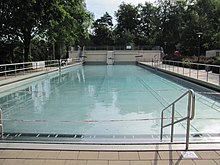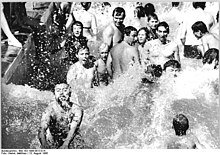Bilzbad
The Bilzbad (also written as Bilz-Bad ), which is now a listed building , is an open-air swimming pool in the Kötzschenbroda Oberort district of the Saxon town of Radebeul , at Meiereiweg 108. The naturopath Friedrich Eduard Bilz opened this "light-air bath" in 1905 in faith in the positive health effects of stay outdoors; his son Willy Johannes Bilz managed it as part of the Bilz corporate conglomerate.
The outdoor pool is located just above the Lößnitzgrund near the Lößnitzgrund stop of the Lößnitzgrundbahn . The Undosa wave machine built in 1912 (lat. Unda - the wave; undosa - the wave kingdom) is the oldest wave machine of its type and, although a technical monument , is still in operation today. The oldest wave pool in the world still in operation, which is still true to the original, was able to look back on a hundred years of existence in 2012.
Monument protection
As early as 1979, the Bilz-Bad (Undosa wave pool) was a monument of architecture in Radebeul . Today two objects are under protection as individual monuments: the former eastern entrance building directly on Meiereiweg, in which the museum exhibition is located, and the outdoor pool, also known as the Undosa wave pool, with the wave machine, which is still used regularly today.
Eastern entrance building
Under the identification Meiereistraße 9108-I , the former eastern of the two entrance buildings with “half-timbered and Bilz bust” is a listed building. Since the renovation, the Bilzmuseum has been showing exhibits on Bilz and its light-air bath. The museum and the restaurant located in the former farm building of the Bilz-Bad are open to the public without admission to the bath.
Undosa wave pool
The over a hundred year old outdoor pool with the Undosa wave machine is also a listed building.
history
Bilz, since 1892 the operator of in Oberlößnitz located Bilz Sanatorium , wanted to supplement this with a "light-air bath", which should be accessible as a public health facility to the public. From 1903 Bilz acquired around 9 hectares of land for this purpose. On April 14, 1905, he applied to the competent authorities: “... to build a forest park for air and sun bathing, in addition ... to enclose the park with a board wall between granite columns. ... In addition, a water basin is to be created. ”This should be supplemented by 50 air bathing cells, 2 bowling alleys, a shelter against rain and a laundry storage shed. The only condition of the building permit, which was granted six weeks later, was not to build a lung sanatorium at this point.
The institution built by the local master builder Wilhelm Eisold was opened on June 25, 1905 as Bilz-Licht-Luft-Bad . In the same year, a building application was issued for a women's air bath, utility and sanitary building and music pavilion. From 1906, Bilz's youngest son Willy Johannes Bilz ran the Bilzbad together with his wife Margarete Ottilie. In 1907 there were already three water basins, in 1908 a kitchen building based on a design by the architect Johannes Heinsius was added. After the construction of “light-air houses”, further, unapproved buildings followed, which is why the authorities imposed fines.
In 1911, the municipality of Kötzschenbroda complained that "the site plans submitted by Bilz had become completely 'unreliable' due to the non-execution of planned and non-requested buildings."
From 1912 the Bilz-Bad was also known under the name Undosa wave pool , due to the installation of the Undosa wave machine on June 28, 1912 (Undosa in German translation: "the wave realms"). This first wave machine was presented at the International Hygiene Exhibition in Dresden in 1911 and immediately bought by Bilz. On June 29, 1912, Bilz, bypassing the responsible municipality, applied directly to the administrative authority in Dresden-Neustadt to be allowed to install this wave machine. With the argument that the community denied him the application anyway, he wrote: "I hope that the laudable administration will do me this favor, since my entire facility serves the public health."
The area grew over the years to about 30 hectares. The originally private access to the site from Lößnitzgrund or the local train station had to be left to the public in response to public pressure in the course of a counter-deal. With the official extension of the Meiereiweg towards the west to Buchholzweg, the area of the Bilzbad was cut into two parts.
In 1927/1928 the Bilz heirs, who continued to operate the Bilz light, air and wave pool , built a dance and social hall designed by Alfred Tischer after receiving a dance and liquor license . From 1931, tenants built permanent dormitories and weekend houses on some of the extensive areas. In the following decades, the Bilz-Bad developed in a disorderly manner into an open-air swimming pool with weekend cottages and some permanent homes.
After the Second World War, Hans-Joachim Bilz (1922–2001) ran the Bilzbad. In 1975 he had to sell it to the city of Radebeul "at a minimum price", and it has been publicly owned ever since. Today it is operated by Stadtbäder und Freizeitanlagen GmbH Radebeul, an independent company of the city as the successor to the former company.
In 1987 there were 486 weekend houses on the Bilz-Bad site, 484 of which were privately owned.
The Bilz summer festivals, which were continued by the surrounding arbor tenants during the GDR era, were held by the Bilz-Bund e. V. , supported by other interested parties, organized as a Bilz-Bad-Fest on the last weekend before the summer holidays.
Between 1992 and 1998, the significantly reduced outdoor swimming pool, which is only located on the south side of Meiereiweg, was completely renovated, including the Undosa wave machine, which can be viewed and is still in use today. In 2012, a new non-swimmer pool was opened, which replaced the island pool that had previously been closed due to dilapidation .
In 2015, almost 49,000 visitors visited the outdoor pool, where a trace boarding route was opened in 2016.
Willy Johannes Bilz
Willy Johannes Bilz, also Hans Bilz, (born January 3, 1884 in Meerane ; † October 21, 1965 in Radebeul ) was a son of the naturopath Friedrich Eduard Bilz . He managed the Bilzbad for the family conglomerate.
Johannes Bilz was the youngest son of Eduard Bilz, who later became a naturopath, born during his time in Meerane as a grocer. In 1889 he moved with the family to Dresden and in 1890 to Oberlößnitz , now part of Radebeul .
From 1906 he ran the Bilz-Licht-Luft-Bad in Lößnitzgrund together with his wife Margarethe Ottilie.
With the death of his brother Arthur Ewald Bilz , the director of the Bilz sanatorium , in 1941 Johannes Bilz was to take over the management of the sanatorium, but in the same year the Wehrmacht took over the sanatorium as a reserve hospital.
Johannes Bilz was buried in the family grave of the Radebeul-Ost cemetery.
literature
- Frank Andert (Red.): Radebeul City Lexicon . Historical manual for the Loessnitz . Published by the Radebeul City Archives. 2nd, slightly changed edition. City archive, Radebeul 2006, ISBN 3-938460-05-9 .
- Volker Helas (arrangement): City of Radebeul . Ed .: State Office for Monument Preservation Saxony, Large District Town Radebeul (= Monument Topography Federal Republic of Germany . Monuments in Saxony ). SAX-Verlag, Beucha 2007, ISBN 978-3-86729-004-3 .
- Jürgen Helfricht : Friedrich Eduard Bilz. Natural healer, philosopher, entrepreneur . Notschriften-Verlag, Radebeul 2012, ISBN 978-3-940200-74-7 .
Web links
- Public health facility in Bilz-Bad
- 100 years of Bilzbad
- History of the Bilz-Licht-Luft-Bad ( Memento from December 3, 2013 in the Internet Archive ) In: Manfred Richter: Radebeul on historical postcards; from yesteryear.
- Historical postcards about the Bilz-Bad ( Memento from December 3, 2013 in the Internet Archive ) In: Manfred Richter: Radebeul on historical postcards; from yesteryear.
- Historical photos of the Bilzbad.
- Location of the area at OpenStreetMap .
Individual evidence
- ^ Large district town of Radebeul (ed.): Directory of the cultural monuments of the town of Radebeul . Radebeul May 24, 2012, p. 25 (Last list of monuments published by the city of Radebeul. The Lower Monument Protection Authority, which has been based in the Meißen district since 2012, has not yet published a list of monuments for Radebeul.).
- ↑ a b c Volker Helas (arrangement): City of Radebeul . Ed .: State Office for Monument Preservation Saxony, Large District Town Radebeul (= Monument Topography Federal Republic of Germany . Monuments in Saxony ). SAX-Verlag, Beucha 2007, ISBN 978-3-86729-004-3 , p. 203 f .
- ^ Frank Andert (Red.): Radebeul City Lexicon . Historical manual for the Loessnitz . Published by the Radebeul City Archives. 2nd, slightly changed edition. City archive, Radebeul 2006, ISBN 3-938460-05-9 , p. 26 .
- ↑ Bilzbad opens the season with a new "trace boarding" facility. In: Dresdner Latest News from May 20, 2016.
Coordinates: 51 ° 7 '22.4 " N , 13 ° 38' 50" E











